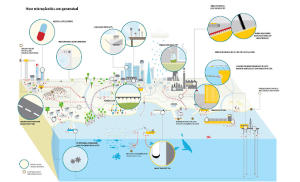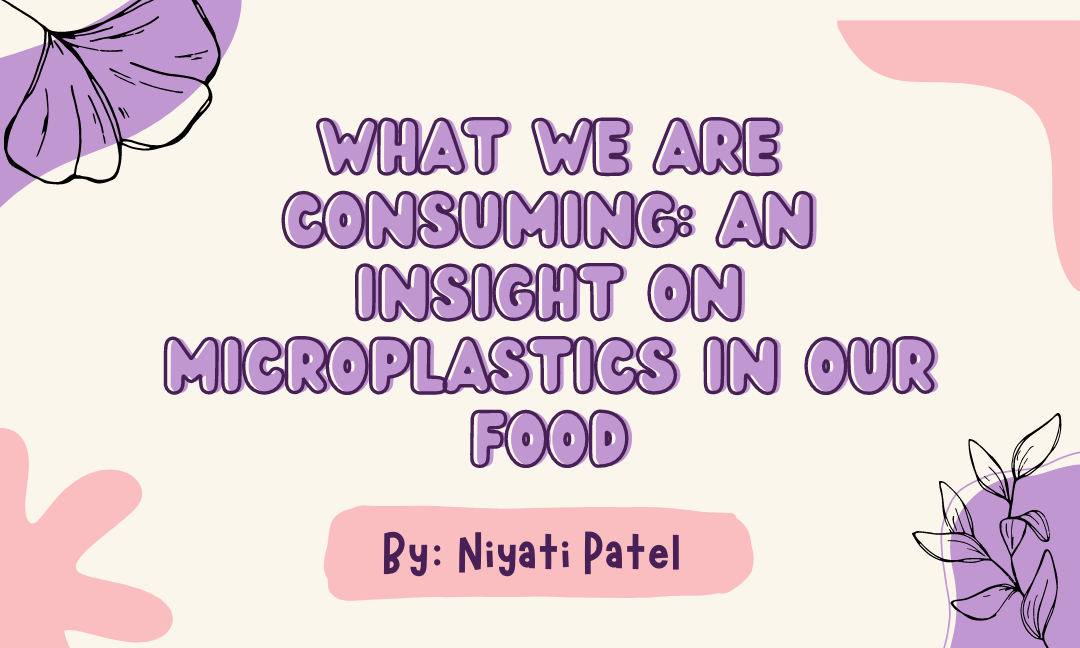Written By: Niyati Patel
Edited By: Morgan Pankarican
Designed By: Jiya Mehta
Published By: Miriam Alonge Wato
The term microplastics is not widely known or recognized by the civil population. However, the UN defines microplastics as, “tiny plastic particles up to 5mm in diameter” and it also recognizes the concerns surrounding microplastics as a threat to the marine environment. Now you might be wondering: What is the big deal about plastic? Plastic is everywhere, and we use it in our daily lives from water bottles to little toys. But microplastics, a specific type of plastic, play a huge role in our ecosystem and they also have a huge impact on us. According to the UN, microplastics pose a significant concern to marine life as these plastics have been found in many of the marine animals we eat. In other words, imagine digesting plastic. Humans interact with microplastics on a daily basis. It is said that humans digest up to 50,000 microplastics per year just from their food intake.

How do microplastics get into our food?
Microplastics are everywhere. So far, they’ve been found in water, in soil, and even in the air. We know that all living things eat and breathe, so, when we eat other animals that have breathed in the contaminated air and drank contaminated water we are automatically digesting these microplastics ourselves. Basically, microplastics have become a part of the food chain.
For those of us who don’t consume a lot of meat, we still consume microplastics. Microplastics are everywhere! For example, microplastics can get into the fruits and vegetables we eat through precipitation. Microplastics in the air and in the water get sucked into clouds: When the cloud opens and rains, that water contains microplastics. The rainwater containing microplastics then gets absorbed by transpiration by the roots of the plants/crops. With that absorption, microplastics enter the plant and into the fruit or vegetable.
How harmful are microplastics?
Research claims that microplastics have the ability to damage human DNA (Deoxyribonucleic acid) and that they have the ability to cause damage to muscle fibers while also causing inflammation and other health problems. Consumption of microplastics leads to the exposure of chemicals and toxic substances that may cause effects similar to that of poisoning in the long-term.
What can we do?

While it is not within human control on whether or not we would like to consume microplastics, there are many ways we can improve our environment to prevent more microplastics from infiltrating our systems. Some things we can do are recycle, reuse, walk or use public transit when possible. If we want to change the course of the problems we see in the world today we must be the change we want to see. Therefore, as a long-term solution we need to reduce the amount of plastic we use and limit the amount of pollutants we release into our air.
Citations:
Microplastics. (n.d.). UNEP – UN Environment Programme. https://www.unep.org/resources/report/microplastics
Mladinich, K. (2021, July 30). How many microplastics are in your body? An insight into lifetime accumulation. Oceanbites. https://oceanbites.org/how-many-microplastics-are-in-your-body-an-insight-into-lifetime-accumulation/
Microplastics: Is there plastic in our fruit and veg? (2020, June 26). BBC Newsround. https://www.bbc.co.uk/newsround/53195056
Are Microplastics Harmful? (n.d.). https://www.poison.org/articles/are-microplastics-harmful#:~:text=Microplastics%20can%20absorb%20unwanted%20and,might%20lead%20to%20poisonous%20effects.
How microplastics are generated. (n.d.). Flickr. https://www.flickr.com/photos/gridarendal/31550420493
Microplastic. (n.d.-b). Flickr. https://www.flickr.com/photos/oregonstateuniversity/21282786668

